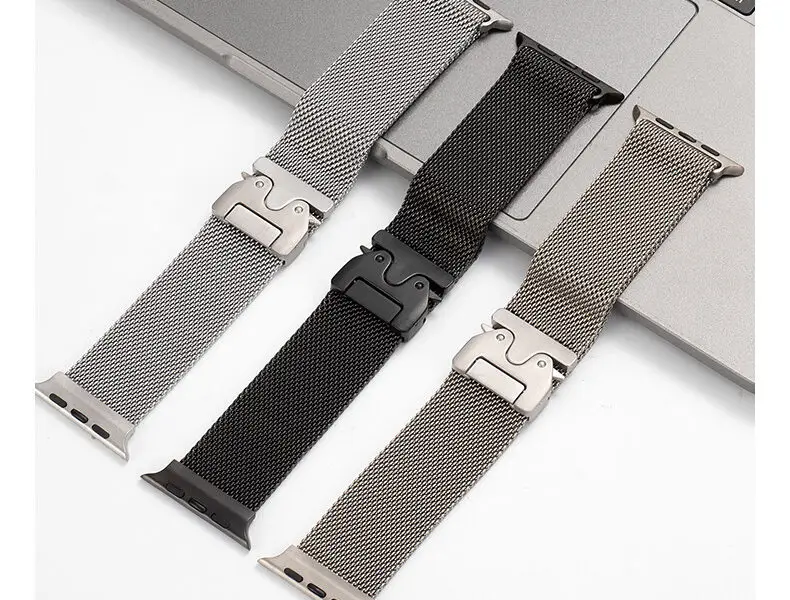
Daily Wear Protection: Minimizing Micro-Damage
Even robust stainless steel bands face invisible threats during routine use. Implement these proactive strategies endorsed by leading brands:
1. Directional Awareness During Wear
Dominant-Hand Priority: Wear watches on your non-dominant wrist (e.g., left wrist for right-handed users). Apple observes this reduces collision risks with door frames, desks, and equipment by over 40%.
Crown Positioning: Rotate watch crowns away from your hand’s motion path. Samsung notes inward-facing crowns on Galaxy Watches prevent accidental impacts during gestures.
2. Fabric Interaction Management
Avoid Abrasive Textiles: Rough materials like wool or denim accelerate “brush finish” erosion. For polished bands (e.g., Rolex Oyster), prioritize smooth-sleeved attire.
Post-Contact Inspection: After contact with coarse surfaces (e.g., brick walls, backpacks), wipe bands immediately with microfiber cloths to remove abrasive particles.
3. Environmental Shielding Techniques
Humidity Control: In tropical climates, apply nano-coating sprays (used by Omega for Seamaster bands) quarterly to create invisible moisture barriers.
Salt Exposure Protocol: If exposed to seawater, follow Rolex’s 3-step rinse:
Immerse in lukewarm freshwater for 5 minutes
Gently brush link joints
Pat dry with chamois leather
4. Impact Mitigation Habits
The “Two-Removal Rule”: Huawei advises removing bands during:
Weightlifting (compression strains links)
Typing sessions exceeding 1 hour (cumulative desk scratches)
Impact Absorption: For active professionals, Garmin recommends switching to silicone bands during high-vibration activities (e.g., motorcycle riding, construction work).
“Micro-scratches aren’t flaws—they’re chapters in your band’s story. But preventable damage? That’s poor authorship.”
— Senior Materials Engineer, TAG Heuer
How to Decide Between Rubber vs. Silicone Watch Straps for Sports Activities?
When it comes to choosing the right strap for your smartwatch during sports or fitness activities, the rubber vs. silicone debate often leaves users confused. Both materials are popular among athletes and fitness enthusiasts for their durability, comfort, and sweat resistance. But which one is truly better for your active lifestyle? Let’s break down the differences and help you make an informed decision based on real-world performance, brand recommendations, and user experience.
Understanding the Basics: What’s the Difference?
At first glance, rubber and silicone watch straps may seem similar — both are flexible, water-resistant, and ideal for sports use. However, there are subtle yet important distinctions:
Rubber straps are typically made from natural or synthetic rubber compounds. They’re known for their strong grip and rugged texture.
Silicone straps, on the other hand, are made from synthetic polymers and offer a smoother, softer feel with superior hypoallergenic properties.
While both materials perform well in sweaty environments, each has its own strengths depending on your activity level and personal preferences.
Comfort and Skin Sensitivity
If you have sensitive skin or wear your smartwatch all day — especially during long workouts — silicone might be the better option. It’s gentle on the skin, non-reactive, and less likely to cause irritation or allergic reactions. Brands like Apple and Samsung often recommend silicone bands for users who engage in daily fitness tracking, emphasizing comfort and breathability.
Rubber, while durable, can sometimes trap heat and moisture more than silicone, potentially leading to discomfort during extended use. However, many Garmin and Fitbit models come with rubber-inspired straps designed specifically for high-intensity sports, offering a secure fit without sacrificing ventilation.
Durability and Longevity
When it comes to durability, rubber tends to hold up better under extreme conditions. It’s naturally resistant to abrasion and maintains its shape even after prolonged use. For example, Huawei’s sport-focused watches often feature rubber-style straps engineered to withstand rough handling and outdoor adventures.
On the flip side, silicone is also highly durable but may show signs of wear over time, especially if exposed to oils, lotions, or harsh chemicals. Still, silicone holds its shape well and doesn’t degrade as quickly as some rubber blends when exposed to UV light or ozone.
Sweat Resistance and Maintenance
Both materials excel in resisting sweat and moisture, making them ideal for running, cycling, gym sessions, and even swimming (depending on your watch’s water rating). That said, silicone is easier to clean — a quick wipe with a damp cloth or mild soap usually does the trick. Its non-porous surface prevents bacteria buildup, helping to reduce odor over time.
Rubber, while just as sweat-resistant, can develop a sticky texture or retain odors if not cleaned regularly. Some users report that rubber straps need more frequent cleaning compared to silicone, especially after intense workouts.
Style and Compatibility
Most modern smartwatches, including those from Apple Watch, Samsung Galaxy Watch, and Garmin Venu, support interchangeable straps, allowing you to switch between rubber and silicone easily. If style is a priority, silicone offers a wider range of colors and finishes, while rubber tends to lean toward a more rugged, utilitarian look.
Many professional athletes and outdoor adventurers prefer rubber for trail runs or extreme sports, while fitness influencers and casual gym-goers often opt for silicone due to its sleek finish and lightweight design.
Final Thoughts: Which One Should You Choose?
In summary:
Choose silicone if:
You have sensitive skin
You want a soft, comfortable fit for all-day wear
You prioritize easy maintenance and hygiene
You care about aesthetics and color variety
Choose rubber if:
You’re into high-intensity or outdoor sports
You need a strap that grips well and stays secure
You value rugged durability and structure
You don’t mind a slightly heavier or textured feel
Whether you go for rubber vs. silicone, both materials are excellent choices for sports and fitness use. The key is to match the strap to your specific activity needs and personal comfort preferences.
So next time you’re lacing up your running shoes or heading to the gym, take a moment to consider what kind of strap will keep your smartwatch secure, comfortable, and looking great through every workout.

